 According to contemporary evolutionary theory, our modern-day birds are direct descendants of dinosaurs. For the longest time, dinosaurs were assumed to merely be the big brothers to our current crop of not-so-terrible thunder lizards, but a recent spat of scientists being attacked by antagonistic pigeons has given rise to the theory that there is a direct link between your Jurassic Park’s raptors and… well… raptors. Huh. Maybe we should have been able to figure that one out earlier. But, regardless of whether or not the Dinosaucers should have had feathers, one thing is obvious: there is a clear and undeniable link between dinosaurs and birds.
According to contemporary evolutionary theory, our modern-day birds are direct descendants of dinosaurs. For the longest time, dinosaurs were assumed to merely be the big brothers to our current crop of not-so-terrible thunder lizards, but a recent spat of scientists being attacked by antagonistic pigeons has given rise to the theory that there is a direct link between your Jurassic Park’s raptors and… well… raptors. Huh. Maybe we should have been able to figure that one out earlier. But, regardless of whether or not the Dinosaucers should have had feathers, one thing is obvious: there is a clear and undeniable link between dinosaurs and birds.
So the link between Big Bird and Barney the Dinosaur is just a matter of evolution, right? Two beloved childhood stars, both literally built to appeal to and educate children. Both sing songs, teach lessons, and share an evolutionary bloodline. On a genetic level, they are practically the same creature.
Except there is one major evolutionary difference: Big Bird is fondly remembered and supported to this day, and Barney the Dinosaur was always universally loathed.
Why? It’s all about love.
Look, we all appreciate Sesame Street as some shining bastion of children’s programming, but, to examine a quote from one of its creators, Big Bird’s chosen street had vaguely sinister sounding origins. Sesame Street was to be a show that would “master the addictive qualities of television and do something good with them”. It is great that there is that “do something good” caveat there, but ignore that little bit, and it almost sounds like Cookie Monster was invented by a supervillain attempting to take over the world. And, regardless of intentions, Sesame Street did take over the world. Sesame Street is a global institution, appearing in as many countries as there are palette swaps for Big Bird. And it is all based on one simple concept: learning should be fun for kids. Education does not all have to be stodgy teachers explaining math in a monotone, it can also be obsessive-compulsive vampires and cranky trash people.
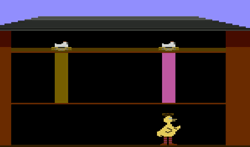 But, as time has gone on, Sesame Street has also become a place where children can learn from puppets how to be more human. Ever since the Snuffleupagus snafu of the 70s, Sesame Street has paid careful attention to guaranteeing the children of yesterday and today not only know how to count cookies, but also how to cope with a cruel and uncaring world of grouches. Sesame Street is not just about goofy songs and guest stars that are comfortable making eye contact with muppets, it is also about addressing children from all walks of life (those born into families both amazing and dreary), and teaching them that they are going to get through this world. Sesame Street is not universal for every child (how could it be?), but it does do its best accommodate as many children as possible, and express that the world may not be perfect, but they are loved.
But, as time has gone on, Sesame Street has also become a place where children can learn from puppets how to be more human. Ever since the Snuffleupagus snafu of the 70s, Sesame Street has paid careful attention to guaranteeing the children of yesterday and today not only know how to count cookies, but also how to cope with a cruel and uncaring world of grouches. Sesame Street is not just about goofy songs and guest stars that are comfortable making eye contact with muppets, it is also about addressing children from all walks of life (those born into families both amazing and dreary), and teaching them that they are going to get through this world. Sesame Street is not universal for every child (how could it be?), but it does do its best accommodate as many children as possible, and express that the world may not be perfect, but they are loved.
And then there’s Barney. Barney just straight up says “I love you” like a jackass. And he does it over and over for every episode! What the hell, dinosaur?!
Barney & Friends, a children’s television show that premiered in 1988, had a similar origin to Sesame Street. It was created to fill a gap, but, while Sesame Street was broadly established to appeal to preschoolers, Barney was aiming for more of the kindergarten set. His creator, Sheryl Leach, believed that her son had outgrown anything available on television and video, so she set out to fashion a singing dinosaur that could entertain children of specific ages. After an initial VHS splash, the concept was graduated from direct-to-video edutainment to a television series in 1992. And from there, Barney & Friends became an American phenomenon, with the purple dinosaur singing everywhere from your television to the toy aisle to the Daytime Emmys. If you were exposed to a child of a certain age in the 90’s, you were exposed to Barney. And his songs would be stuck in your head for the rest of the day…
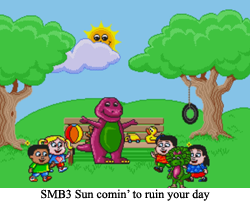 Oh, and if you didn’t have a kid around that demanded to see Barney, you were probably familiar with the creature, too. Barney had a bit of a… negative following. Or, put another way, to my knowledge, this is the first time I am covering something on this blog that had a roleplaying book dedicated to a “jihad” to destroy it. Barney was almost universally loathed. Yes, of course there were “kids”, preteens, and other sarcastic malcontents that made up “funny” songs about barbequing the purple dinosaur’s head, but the whole antipathy enterprise leaked into adult entertainment, too. Remember The Critic? An obvious descendent of The Simpsons, and one of the few dittos of the era to actually be funny? A full half of its fifth episode was given over to an extended parody of Barney the Dinosaur (Humphrey the Hippo… why do I remember that unbidden?). This was a primetime show! For adults! Mostly! And they dipped into the “Barney sucks” well immediately. And if you needed something less animated, Barkley was dunking (literally) on Barney on Saturday Night Live. Barney was an object of scorn everywhere for a few years, and people were able to massively profit off the previously mentioned RPG sourcebook based on destroying Barney, or ersatz appearances like Mr. Huggles in a 2007 Xbox game (Monster Madness, incidentally). And more than a few Youtube careers were launched by involving “a Barney” in one way or another…
Oh, and if you didn’t have a kid around that demanded to see Barney, you were probably familiar with the creature, too. Barney had a bit of a… negative following. Or, put another way, to my knowledge, this is the first time I am covering something on this blog that had a roleplaying book dedicated to a “jihad” to destroy it. Barney was almost universally loathed. Yes, of course there were “kids”, preteens, and other sarcastic malcontents that made up “funny” songs about barbequing the purple dinosaur’s head, but the whole antipathy enterprise leaked into adult entertainment, too. Remember The Critic? An obvious descendent of The Simpsons, and one of the few dittos of the era to actually be funny? A full half of its fifth episode was given over to an extended parody of Barney the Dinosaur (Humphrey the Hippo… why do I remember that unbidden?). This was a primetime show! For adults! Mostly! And they dipped into the “Barney sucks” well immediately. And if you needed something less animated, Barkley was dunking (literally) on Barney on Saturday Night Live. Barney was an object of scorn everywhere for a few years, and people were able to massively profit off the previously mentioned RPG sourcebook based on destroying Barney, or ersatz appearances like Mr. Huggles in a 2007 Xbox game (Monster Madness, incidentally). And more than a few Youtube careers were launched by involving “a Barney” in one way or another…
So this brings us back to a simple question: Why? There have always been Sesame Street parodies, but none possessed the same consistent vitriol we all saw in the Barney universe. Why was Barney so universally, consistently despised?
Maybe it’s just because he loved too much.
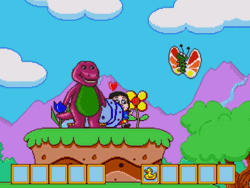 Barney is supposed to be a big, purple manifestation of unconditional love. He loves you, you love him, we’re a great big family. Barney is great for kids, because his unconditional love of the audience tells children that there are people out there that will love you no matter what. That is a great moral! But, to anyone over the age of five, it sounds an awful lot like bullshit. In fact, that very bullshit is likely a significant reason why Barney was so loathed. A generation of kids that had just experienced He-Man, G.I. Joe, and Ninja Turtles was now seeing the next generation (or their little siblings) being influenced by Barney the Lover. And, whether anyone really understood what was happening, they all recognized this… deception. Barney did not love you. Barney did not even know you. And neither did Prince Adam of Eternia, Sargent Slaughter, or Leonardo, but they all took time out of their day to give you some Sailor Says knowledge and sell a few toys for a half hour a day. They didn’t know you, they didn’t care about you, but they made you think they cared about you. And you, a stupid kid, bought it, literally, every time you waddled into Toys R’ Us. And an entire generation was just starting to realize this. He-Man had retired. The Ninja Turtles were losing shelf space to the Power Rangers. Our lovers had left us, and here was a new sucker ready to be tricked by the latest dinosaur of love. He’ll leave you like they all left us, Little Timmy! Do not love Barney! He doesn’t really love you! Flush his body down the potty while you can!
Barney is supposed to be a big, purple manifestation of unconditional love. He loves you, you love him, we’re a great big family. Barney is great for kids, because his unconditional love of the audience tells children that there are people out there that will love you no matter what. That is a great moral! But, to anyone over the age of five, it sounds an awful lot like bullshit. In fact, that very bullshit is likely a significant reason why Barney was so loathed. A generation of kids that had just experienced He-Man, G.I. Joe, and Ninja Turtles was now seeing the next generation (or their little siblings) being influenced by Barney the Lover. And, whether anyone really understood what was happening, they all recognized this… deception. Barney did not love you. Barney did not even know you. And neither did Prince Adam of Eternia, Sargent Slaughter, or Leonardo, but they all took time out of their day to give you some Sailor Says knowledge and sell a few toys for a half hour a day. They didn’t know you, they didn’t care about you, but they made you think they cared about you. And you, a stupid kid, bought it, literally, every time you waddled into Toys R’ Us. And an entire generation was just starting to realize this. He-Man had retired. The Ninja Turtles were losing shelf space to the Power Rangers. Our lovers had left us, and here was a new sucker ready to be tricked by the latest dinosaur of love. He’ll leave you like they all left us, Little Timmy! Do not love Barney! He doesn’t really love you! Flush his body down the potty while you can!
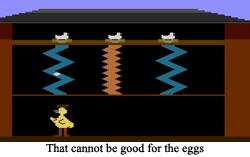 That is the difference between Big Bird and Barney. Despite a similar evolution, they are both the products of very different times. Big Bird loves you, but it is not his whole identity. Barney exists in a world wherein he cannot conceive of being unloved, and, while that works for some ages, it does not for people starting to understand all their heroes were little more than toy commercials. And, as a result, to this day, Big Bird continues to star in any number of counting-based videogames, while Barney never escaped the Sega Genesis. Love did not keep Barney alive, and it never could. In our modern world, Big Bird still stalks the Earth, while Barney is extinct. A big, purple evolutionary dead end.
That is the difference between Big Bird and Barney. Despite a similar evolution, they are both the products of very different times. Big Bird loves you, but it is not his whole identity. Barney exists in a world wherein he cannot conceive of being unloved, and, while that works for some ages, it does not for people starting to understand all their heroes were little more than toy commercials. And, as a result, to this day, Big Bird continues to star in any number of counting-based videogames, while Barney never escaped the Sega Genesis. Love did not keep Barney alive, and it never could. In our modern world, Big Bird still stalks the Earth, while Barney is extinct. A big, purple evolutionary dead end.
… Or maybe just nobody liked his songs. Man, I’m not a paleontologist.
FGC #575 Big Bird’s Egg Catch
- System: Atari 2600. It’s got pretty good graphics for an Atari title!
- Number of players: Two player alternating. Likely assuming their audience were literal preschoolers, that alternating happens pretty damn often. You don’t have to wait for your turn for long.
- Maybe actually talk about the game for a second: This is a game for babies… and surprisingly well-balanced for multiple ages. The lower-difficulty levels see a Big Bird that automatically magnetizes to where an egg falls, but later stages allow the player to more precisely position the bird so as to more effectively fail at catching an egg. Oh, and the chutes get more zig-zaggy. And invisible. That makes things complicated!
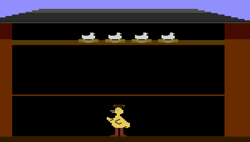 You are in Control: Big Bird’s Egg Catch was built for the Atari Kid’s Controller. That controller was, essentially, a num pad. It was basically only built for educational/egg-based games. But since it had more buttons and was more complicated than your typical Atari “paddle”, it was kind of ironic that this became the “Kid’s Controller” and not “Accountant’s Delight”.
You are in Control: Big Bird’s Egg Catch was built for the Atari Kid’s Controller. That controller was, essentially, a num pad. It was basically only built for educational/egg-based games. But since it had more buttons and was more complicated than your typical Atari “paddle”, it was kind of ironic that this became the “Kid’s Controller” and not “Accountant’s Delight”.- Goggle Bob Fact: Many of “my” Atari games were games my grandfather found interesting (like Pac-Man) that I incidentally got to play. But I want to say Big Bird’s Egg Catch was the first videogame ever distinctly purchased for “Little Bobby”. Either that or my grandfather really liked gigantic birds.
- How about that Barney Genesis Game? Barney’s Hide & Seek Game (yes, “Game” is part of the title) is basically a platforming title wherein you find marginally hidden children (and one child dinosaur). As much as it would make sense, It is not a “find in the picture” game, and it definitely controls like a Mario title… albeit a Mario title wherein our hero is trapped inside of a bulky dinosaur costume. Barney steers like a drunk truck is what I am saying. Regardless, it is not nearly as fun as catching eggs with Big Bird, but it… uh… exists? Technically? I guess it officially has significant (for the time) voice acting, so that’s nice.
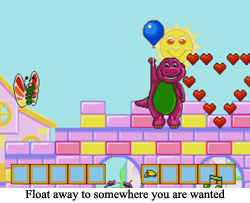 Did you know? Barney’s “I Love You” song was used for psychological torture at Guantanamo Bay detention camp. That’s the fact. No moral.
Did you know? Barney’s “I Love You” song was used for psychological torture at Guantanamo Bay detention camp. That’s the fact. No moral.- Would I play again: Big Bird’s Egg Catch could work as some kind of cell phone title that is played for like ten minutes while waiting for your shots. But am I going to break out the 2600 to play it some more? Nah.
What’s next? Random ROB has chosen… Contra for the NES! We are going from loving birds and dinosaurs to extremely unloving commandos! Please look forward to it!

The huge difference between Sesame Street and Barney and Friends – heck, between Sesame Street and most edutainment shows – is that the show goes to efforts to humanize its cast.
In Sesame Street, we really get to know the cast. Cookie Monster is driven by his hunger and can be surprisingly manipulative. The Count has OCD when it comes to counting things. Telly is neurotic and tends to have confidence issues and overreact to things (even imagined ones). Grover wants to be helpful but is oblivious to how unhelpful he is. Oscar the Grouch is a curmudgeon and an asshole.
Characters’ personalities can come into conflict with one another (this is what makes Grover v. Blue Guy and Kermit v. Anybody sketches so much fun), and characters can be frightened or sad for extended periods of time and we will feel for them because we know them. Sesame Street was designed so that parents might watch it with their kids instead of just as a thing to distract them on the TV/mobile, and it shows.
In contrast, Barney the Dinosaur (going by the 90s stuff here) feels very…manufactured. Barney is happy and giggling 24/7, even when he stubs his tail or gets stuck. Practically all of his songs are public domain(…ish) in contrast to the many original songs to come from Sesame Street. Even the emotional bits themselves feel manufactured, the show doesn’t do much to establish personalities for its cast members.
For a show that was allegedly aimed at an older audience, Barney and Friends feels far more childish than Sesame Street.
[…] & Watch game (that we will never see again): Mickey Mouse had his own Game & Watch game. Like another children’s star, it was a game involving our hero grabbing eggs from chickens. Minnie was responsible for […]